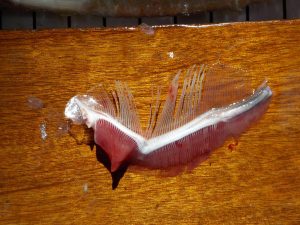
Gill rakers (above gill arch) from an American Shad Alosa sapidissima are not to be confused with gill filaments (below); they are particularly important for filter-feeding fish (photo credit: NOAA).
While gill rakers have no role in gas exchange, the predominant function of gills, they do perform an equally important function for filter-feeding fish – food acquisition. These bony projections serve as a sieve to trap food particles. They vary greatly in length and number and these characteristic differences have evolved with different feeding strategies for fish. A plankton feeder, for example, such as American Shad Alosa sapidissima, has very tightly-packed, comb-like, gill rakers to efficiently filter their food from the water column. An omnivore or piscivore, on the other hand, has shorter, more widely-spaced gill rakers, better for larger prey items. In fact, the morphology of gill rakers is so diverse that they are often used as a taxonomic tool to identify and classify fish species (e.g., gill raker counts can differentiate species on a dichotomous key).
